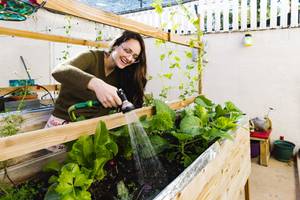Our carbon footprint is the measure of the greenhouse gases—particularly carbon dioxide—that we individually and collectively generate and release into the atmosphere. This includes energy we use every day, including fossil fuels for transportation and electricity.
According to the Nature Conservancy, “The average carbon footprint for a person in the United States is 16 tons, one of the highest rates in the world. Globally, the average is closer to 4 tons.”
The cumulative effect of the world’s carbon footprint is the direct cause of global warming. In order to avoid the catastrophic 2 degrees Celsius (3.6 degrees Fahrenheit) increase in temperature that’s predicted if we continue at our current levels of consumption, we need to reduce our carbon footprint, at the individual level, to 2 tons.
While it would be challenging to give up our cars in our vehicle-dependent city or to forgo electricity, one area where we can reduce our carbon footprint is in our kitchen. It will benefit the planet—and our health, in the process. Here are some ways to start.
Aim for a zero-waste kitchen. It’s estimated that Americans throw away 80 billion pounds of food a year—around 220 pounds per person. Food waste accounts for nearly a quarter of material in landfills, and that waste releases potent greenhouse gases as it decomposes. Save money and the planet and aim for a zero-waste kitchen by planning meals and eating leftovers.
Eat more plants and less meat. One of the worst culprits in emitting greenhouse gas emissions? Cows, which give off massive amounts of methane. According to the Food and Agriculture Organization of the United Nations, agriculture releases 18% of greenhouse gases worldwide, surpassing even the transportation sector, with livestock using 30 percent of the Earth’s land surface. You don’t have to go vegan to make a difference; start with a meatless meal once a week.
Cut back on dairy, too. No one wants to give up cheese, but the reality is, it takes a lot of milk to produce it. As a result, cheese production emits more greenhouse emissions than producing pork, eggs and chicken. For your morning cereal, try various plant-based milk alternatives available at your local grocery store.
Learn to love ugly produce. Misshapen fruits and vegetables are thrown out because consumers think they’re subpar. But they’re just as nutritious as their photogenic counterparts. Give love to the ugly ones and save them from the landfill. You can even sign up for delivery services from online grocers like Imperfect Foods (imperfectfoods.com) and Misfits Market (misfitsmarket.com) at a steep discount.
Grow your own garden. If you’re a novice, start with common kitchen herbs. Then expand your repertoire to include seasonal produce, like tomatoes and peppers. If you don’t have garden space, rent a plot at a community garden like Vegas Roots (vegasroots.org), where you’ll get lots of support from expert gardeners.
Eat seasonally. One of the most magical things about fruits and vegetables is anticipating them coming into season—juicy blueberries and sweet corn in the summer, pumpkins in the fall, sweet potatoes in the winter. We were never meant to enjoy these seasonal treats year-round, and their off-season availability comes at a great cost to the environment, since they have to be transported from elsewhere. Make a habit of visiting farmers markets, and you’ll be rewarded with produce at its peak. Plus, you’ll be supporting local producers.
The future is … more plastics. But it doesn’t have to be. We all know by now that our planet is clogged with plastic (300 millions tons are produced each year). Google the Great Pacific Garbage Patch to see exactly where that plastic bag from the grocery store or water bottle from the gas station could end up. This vortex of trash in the middle of the ocean spans an area twice the size of Texas, and it’s growing by the day. In less than 30 years, there will be more plastic (by weight) in our oceans than fish. But we can do our part by using our own bags at the grocery store, cutting back on single-use plastics and cooking our own food to reduce our reliance on plastic takeout containers.





